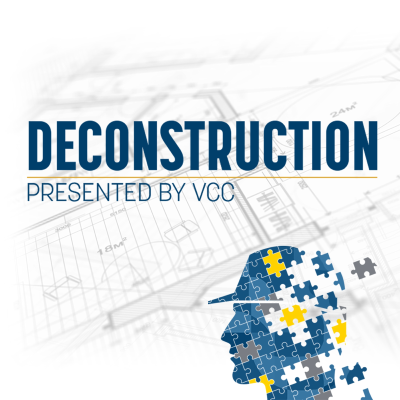
Deconstruction
Englisch
Gratis en Podimo
Kostenlos hören bei Podimo
Starte jetzt und verbinde dich mit deinen Lieblingspodcaster*innen
- Vertraut von über 1 Mio. deutschen Hörer*innen
- Über 1.000 lokale Podcasts und Shows – nur bei Podimo
- Keine Zahlung nötig
Mehr Deconstruction
Welcome to Deconstruction, the VCC Media Channel. Join us for thought leadership on how we can build better, together.
Alle Folgen
11 FolgenWomen in Construction Featuring Nancy Rodriguez
Women’s History Month, which kicks off each March after its official designation in 1987, is a great time to recognize the importance and value of women in the workforce. Construction is one industry striving to welcome more women into its field. As of 2020, women comprised only 9% of the construction industry. Celebrating its 35th year in the building and construction industry, VCC looks to highlight the many contributions of the women leading the construction movement with its spotlight series, VCC Women in Construction. Host Michelle Dawn Mooney got recently acquainted with one such leader, Nancy Rodriguez, VCC’s Senior Risk Manager. Rodriguez joined VCC nine years ago as an assistant risk manager, and she’s continued her work with VCC up through her current role. Rodriguez spoke with Mooney about her construction career journey. Their discussion includes: * How Rodriguez’s father’s masonry background influenced her interest in pursuing a construction career * The aspects of Rodriguez’s job that motivate her * The rewarding aspects of being a woman in construction “We’re problem solvers, as women, and so my perspective on many things is what gets it done,” Rodriguez said. “That is very rewarding because we target problems differently as women. Most of us are multitaskers; we have children and schedules to try to be at work and coordinate school and events. It’s rewarding to me to be able to know I have a handle on what’s happening in my department, and I feel fulfilled.” Nancy Rodriguez is a risk management specialist with experience in construction risk and insurance. Rodriguez is also a notary public in Arkansas and received her BS in Biology/Biological Sciences from the University of Arkansas at Little Rock.
Women in Construction Spotlight Featuring Gabby Saenz
A recent study highlighted six major challenges faced by women in the construction industry. The construction industry is a traditionally male-dominated field, but there are many career opportunities for women who are interested in the construction industry. On today’s episode of the VCC Women in Construction miniseries, host Gabrielle Bejarano speaks with Gabby Saenz, Project Manager with VCC Construction, to discuss the involvement and experiences of women in the construction industry. Saenz developed an interest in construction from a young age, when she would accompany her aunt, an architect, to building sites. She eventually pursued a career in the field and is now a fully-fledged project manager in the industry, which is a significant accomplishment for her and an inspiration for women looking to pursue a career in construction. Bejarano and Saenz discussed: * Challenges within the construction industry * Experience working in the construction industry as a woman * Is it worth having a career as a woman in the construction industry? “The best part of being in construction is seeing projects evolve and come to life from the designs on the paper to an actual building. A career in the construction industry is a great choice. It is rewarding and fulfilling to see a project evolve from designs to actual buildings. Imagine driving by a project you worked on, you will feel proud as a member of the team. Women can be significant members in the construction industry - women need to be proud of their work, let their abilities speak for them and never be afraid to speak up,” explained Saenz. Saenz received her B.S. degree in Architecture and B.S. degree in Construction Science and Management from The University of Texas at San Antonio. Saenz has been working at VCC since 2015.
Women in Construction Spotlight Series Featuring Michelle Luce-Gilson
Females encompass only 14 percent of the construction industry’s employees. However, that number is only expected to grow as women take on more engineering and leadership roles. What is it like to work in the construction industry as a female leader, and how can other women make a career in this industry? On today’s episode of the VCC Women in Construction Spotlight Series, Host Michelle Dawn Mooney speaks with Michelle Luce-Gilson, Corporate Scheduler at VCC Construction, Project Scheduler for VCC, to discuss Luce-Gilson’s responsibilities, her experience as a female in the construction industry, and how the industry has changed throughout her career. Mooney and Luce-Gilson also discussed… * What Luce-Gilson does on a day-to-day basis as a scheduler and her experience as a female in a male-dominated industry * What changes Luce-Gilson has noticed over the years in the construction industry * Advice for women who may be hesitant about working in construction How can females figure out the best role for them in the construction industry? “Do something you really love in construction. To get started, do anything in construction and try to figure out where your place is and then go with it,” Luce-Gilson stated. “The industry offers a lot—a really wide array of roles. It’s not just the operations side where there’s people physically building things,” she added. Michelle Luce-Gilson is Corporate Scheduler at VCC Construction and has previously worked in roles such as Scheduling Manager and Senior Project Scheduler at VCC. Luce-Gilson has over 30 years of experience in the construction industry and is a certified Planning and Scheduling Professional (PSP) per the AACE International.
The Social Impact Panel, featuring Eric Coleman, Stacy Bruce, and Derek Alley
Community describes a group of people that live in the same place or share similar characteristics. Every community is different, but one commonly shared theme is how businesses can impact their respective communities. Corporate philanthropy can spure great societal impact. But what causes are companies giving back to the communities they operate in and why? On today’s special episode of the Deconstruction podcast series, host Gabrielle Bejarano chats with panel guests Derek Alley, CEO of VCC, Stacy Bruce, President and Executive Director, Variety -the Children’s Charity of Texas, and Eric Coleman, Dallas Fort-Worth Regional Superintendent, KIPP DFW. The four examine…. * How large companies, like VCC, can give back to the community they operate out of * Why VCC has chosen Variety and KIPP DFW as two organizations to create social impact * What particular missions drive Variety and KIPP DFW to continue serving the community “Regardless of what industry you’re in, community drives everything in our world and if you’re not an active participant in that…I think you’re missing a great opportunity to not only fulfill a deeper mission but also, you know, do real good that can be very much aligned with your corporate goals,” said Alley. As the CEO of VCC, Alley has worked to help grow the company for the past forteen years. Prior to his role with VCC, Alley worked as an Analyst for companies such as BlackRock and DeutscheBank. Alley earned his B.S. in Management Science and Engineering from Stanford University. Stacy Bruce has been an active advocate within the child welfare system for over 25 years. She has served in various roles which include experiences in the direct delivery of services and administrative and agency leadership roles. Bruce is a graduate of The University of Texas at Austin with a BA in Psychology and a MS in Social Work. Coleman has worked for KIPP DFW for over twelve years. As the Head of Schools, Coleman works to encourage underserved youth and empower development in education. Coleman is a graduate of Southern University and Agricultural and Mechanical College at Baton Rouge with a BS in Mathematics.
The Comprehensive Role for Quality Control in Project Planning and Implementation with Jon Herring
Jon Herring, the Quality Control Director of VCC, joins Gabrielle Bejarano in this episode to discuss the role of quality control at VCC and how substitutions in supplies create complications. The VCC's Total Quality Management (TQM) department starts by assessing risk on jobs. TQM ensures the plan is in place and its key players understand their responsibility. Once construction begins, the team is on the ground to ensure that what was agreed is happening. Herring said, “TQM is a real-time feedback loop of understanding the consequences of decisions.” Battling with a shortage of supplies has forced VCC into more flexibility. Herring recalled, “No substitution policy, we don’t like to offer alternatives historically, but these days that’s not possible. Owners are demanding it, and designers need it.” Without substitutions, there are significant delays in building and supplier costs and lead times are rising. Project execution times have increased. It is expected that these trends will continue. Due to the changing landscape, projects experience many iterations. “They have to have a design that works based on the materials available,” said Herring. Materials change, and designs are reworked. “Owners have a lot of options still, but it's a matter of timing and price they’re willing to pay,” noted Herring. TQM's role has become more complex with the changes in the supply market. Each time a substitute is introduced, the product has to be thoroughly understood so that future impact and consequences can be considered. Herring said, “Every product is slightly different. Vetting products each and every time…Paying attention to the implications of the changes is the key.” To learn more about VCC, visit the website vccusa.com.















































